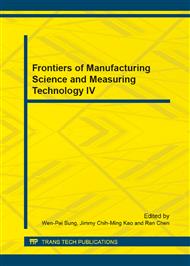[1]
Yuhua Zheng, Yeju Huang, Mei Yang, et al. Synthesis and tunable luminescence properties of monodispersed sphere-like CaWO4 and CaWO4: Mo/Eu, Tb. J. Journal of Luminescence, 2012, 2(132): 362-367.
DOI: 10.1016/j.jlumin.2011.09.010
Google Scholar
[2]
Yanhua Shen, Wen Li, Taohai Li. Microwave-assisted synthesis of BaWO4 nanoparticles and its photoluminescence properties. J. Materials Letters, 2011, 19-20(65): 2956-2958.
DOI: 10.1016/j.matlet.2011.06.033
Google Scholar
[3]
Jing Yan, Yanhua Shen, Rong Cao, et al. CdWO4 nanorods: Ultrafast synthesis via a PEG-1000 polymer-assisted enhanced microwave synthesis route and their photoluminescence property. J. Ceramics International, 2014, 6(40): 8081-8085.
DOI: 10.1016/j.ceramint.2014.01.003
Google Scholar
[4]
Xiaohong Yi, Jianchang Yu, et al. Hydrothermal preparation and luminescence of CdWO4 nanorods. J. Journal of the Chinese Ceramic Society, 2010, 38(2): 212-214.
Google Scholar
[5]
Gang Fang, Ying Xiong, Yuanlin Zhou. Investigation of Synthesis and Luminescent Properties of Y3+ Doped PbWO4 Microcrystals. J. Materials Review B:Research, 2011, 25(11): 20-24.
Google Scholar
[6]
Tatjana D. Savic´, Ivana Lj. Validzˇic ´, Tatjana B. Novakovic, et al. A Synergy of ZnO and ZnWO4 in Composite Nanostructures Deduced from Optical Properties and Photocatalysis. J. Journal of Cluster Science, 2013, 3(24): 679-688.
DOI: 10.1007/s10876-013-0562-7
Google Scholar
[7]
Ivana Lj. Validžić, Tatjana D. Savić, Radenka M. Krsmanović, et al. Synthesis, strong room-temperature PL and photocatalytic activity of ZnO/ZnWO4 rod-like nanoparticles. J. Materials Science and Engineering: B, 2012, 5(177): 645-651.
DOI: 10.1016/j.mseb.2012.03.044
Google Scholar
[8]
Kuisheng Yang, Xun Bai. Preparation and Luminescence Property of ZnWO4: Er3+, Yb3+ Nanorods. J. Chinese Journal of Inorganic Chemistry, 2010, 6(26): 1079-1082.
Google Scholar
[9]
Caina Jiang, Rongfang Wang, Tao He, et al. Preparation and Photoluminescence Properties of SiO2@ZnWO4: Eu3+ Phosphor. J. ChineseRareEarths, 2012, 5(32): 89-90.
Google Scholar
[10]
Xiaowei Zhang, liyun Cao, et al. Influence of Reaction Time on Morphology and Optical Property of ZnWO4 Nanocrystallites Prepared by Microwave Hydrothermal Process. J. Journal of the Chinese Ceramic Society, 2012, 40(9): 1332-1334.
Google Scholar


